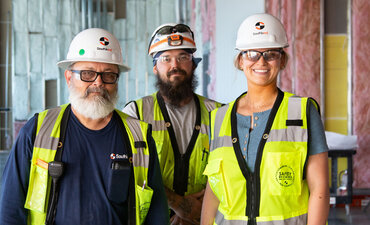
Talking to a coworker, friend, or loved one about suicide can be a difficult situation, but with a little insight to some reasons, techniques, and resources, we — as fellow employees — can help. Every year, the construction industry has one of the highest suicide rates in the country. For every 100,000 workers, 45.3 will die by suicide compared to the national average rate of 14.2. This means that a person working in construction is 3.5 times more likely to die by suicide.
Construction trades & suicide rates
According to a 2020 study by the Centers for Disease Control and Prevention, the top suicide rates (per 100,000 workers) for the Construction occupation groups are:
- Structural Steel Workers – 79
- Construction Laborers – 62
- Construction Equipment Operators – 52.8
- First Line Supervisors of Construction Trades – 44
- Electricians – 44
- Pipelayers, Plumbers, Pipefitters, and Steamfitters – 35.4
Why are the rates higher in construction?
Construction is a predominantly male industry, and as such is at a higher risk due to men being 4 times more likely to die by suicide than women. Not only are construction workers more likely to die by suicide, but according to a study by the National Safety Council, they are almost 20% more likely to have a substance use disorder.
Given the extreme physical nature of construction, with employees often dealing with chronic pain from years of heavy labor or a prior injury, substance use has become much more prevalent, leading to an increase in mental illness. Combine that with the second highest prevalence of alcohol dependency among all occupations, and the picture starts to become a bit clearer. As a company and an industry, we must learn the warning signs and be comfortable having these difficult conversations with our fellow workers.
Recognizing the warning signs
Warning signs of someone at risk of suicide:
- Often talk about wanting to kill themselves or die
- Mention that they feel hopeless, trapped, or have no reason to live anymore
- Tell you they feel like they are a burden to the people around them
- Isolate themselves or withdraw from the people and things they love
- Are showing signs of extreme mood swings
- Increase their alcohol and drug usage
- Are behaving recklessly or taking risks they wouldn't usually take
- Sleeping a lot more or less than normal
- Call you or other loved ones to say goodbye
What should you do if you think someone is at risk of suicide?
Having a conversation with someone that is contemplating suicide is never easy, but if we are prepared and know some effective strategies, it can make a difference. Examples of strategies include:
- Use active listening to build trust and empathy
- Minimize distractions and give them your complete attention
- Be cognizant of your nonverbal communication – i.e., maintain eye contact and nod
An important thing to remember is to refrain from trying to "fix" or "solve" their mental health challenges. Instead, try to understand and sympathize, which can help to motivate them to find relief from within.
Most importantly, encourage them to seek treatment. You can help by providing suicide prevention resources or connecting them with crisis services.
Suicide prevention resources
There is no shortage of available resources for friends, family, and coworkers. The hardest part of getting help is not finding the resources — it is making the decision to do so. With increased awareness and promoting the fact that it is okay to not be okay, we can help make a difference in someone's life.
- Call, text, or chat 988 for the National Suicide Prevention Lifeline
- Talk to your family doctor or a mental health professional
- Find resources at ConstructionSuicidePrevention.com
- Use the Centers for Disease Control and Prevention's free and confidential resources to help you figure out the best path toward overcoming your mental health challenges
Corporate Safety Manager
As a Corporate Safety Manager for Southland Industries, Matt Black is responsible for supporting the divisions' safety needs, providing all safety personnel with guidance and training, assisting with the development and implementation of our safety policies and procedures, and supporting our safety platform, NextCode.




